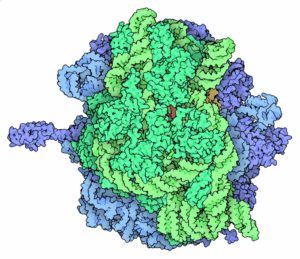

Ribosomes are the cell machines for protein synthesis (pictured; image credit). In bacteria they are composed of 52 proteins and 3 RNAs; the eukaryotic counterparts have 80 proteins and 4 RNA molecules.
A systematic search of genome sequences from cultivated viruses (e.g. those that have been propagated in cell culture) revealed 5 ribosomal protein genes in 16 viral genomes. These include one virus of eukaryotes (a murine sarcoma virus) and 15 bacteriophages.
Next, ribosomal proteins were sought in uncultured viruses – in other words, genome sequences of viruses that have not been propagated in cells. Thirteen ribosomal protein genes were identified. Most of the hosts of these viruses are not known, but about 5% were identified as bacterial.
These viral ribosomal protein genes, likely captured from cellular hosts, appear to be under strong purifying selection, the removal of deleterious sequences. This observation suggests that they have functions in the viral genomes.
When the genes encoding two of these ribosomal proteins were expressed in the bacterium E. coli, the protein products were incorporated into ribosomes. Whether they contribute to the regulation of protein synthesis is a question that should be experimentally addressed.
What is the function of ribosomal protein genes in viral genomes? A likely answer is that they allow modulation of protein synthesis to favor viral proteins over host proteins. Whether or not this hypothesis is correct can be experimentally answered by removing the ribosomal protein genes from the viral genomes and determining the effect on viral reproduction.
I€™m sure as we identify more and more viral genome sequences we will find additional components not previously discovered. However their discovery will not, as the authors suggest, ‘further blur the borders between viruses and cellular life forms€™. The essential feature of viruses is that they are packages of genes that require host cells to provide not only essential proteins for their reproduction, but a structural environment that facilitates this process. When a virus is discovered that has all the genes required for its reproduction, it will likely still require a cellular environment. If that is not needed, then what we are looking at is not a virus but a cell.

Pingback: Ribosomal proteins encoded in viral genomes – Virology Hub
Most interesting, thank you for updating an 80’s science graduate!
Pingback: Ribosomal proteins encoded in viral genomes -